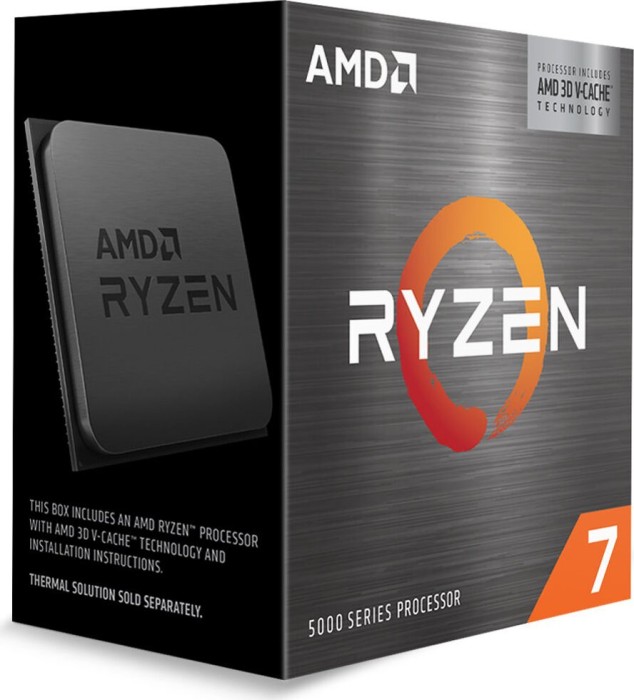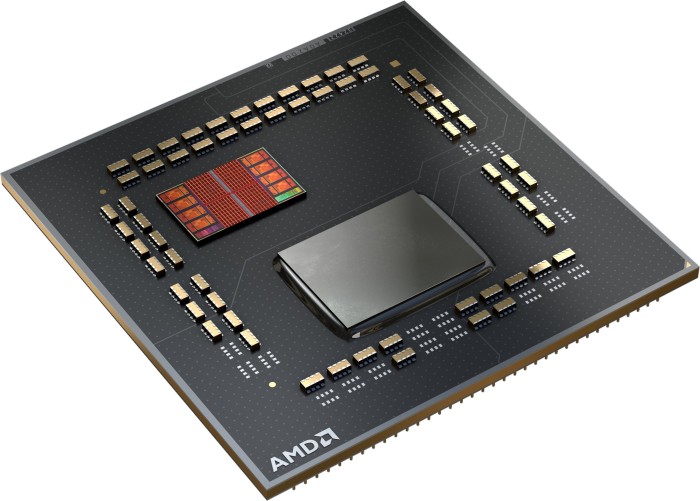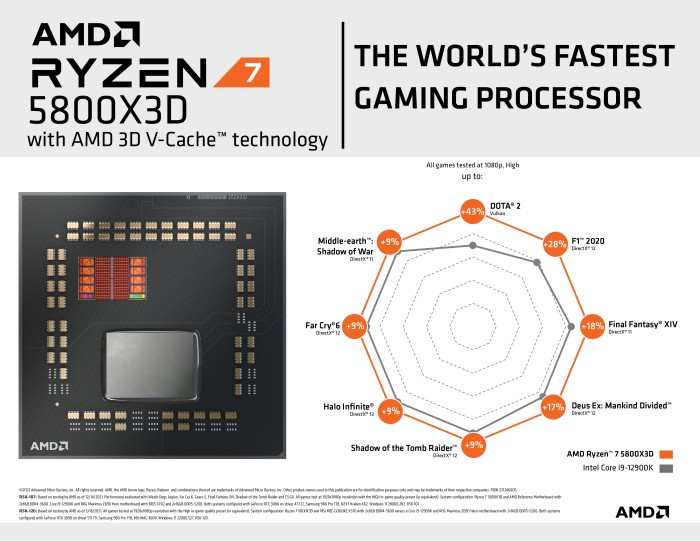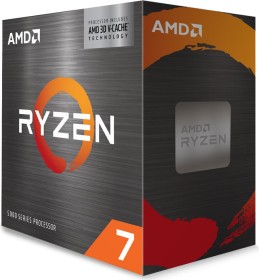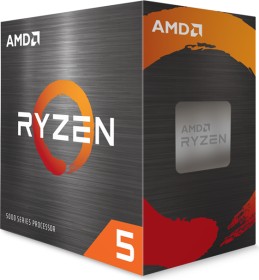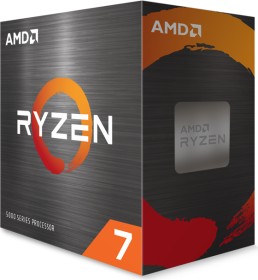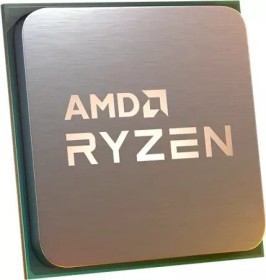AMD Ryzen 7 5800X3D, 8C/16T, 3.40-4.50GHz, boxed ohne Kühler
100-100000651WOF- Kerne
- 8 (8C)
- Threads
- 16
- Turbotakt
- 4.50GHz
- Basistakt
- 3.40GHz
- TDP
- 105W
- Grafik
- nein
- Sockel
- AMD AM4 (PGA1331)
- Chipsatz-Eignung
- A520, B550, X300 (AM4), X570 (modellabhängig: A320, B350, B450, X370, X470)
- Codename
- Vermeer
- Architektur
- Zen 3
- Fertigung
- TSMC 7nm (CPU), GF 12nm (I/O)
- L2-Cache
- 4MB (8x 512kB)
0 Angebote
Bitte die EU-Übersicht verwenden oder ggf. die Filterkriterien ändern.
Weitere Varianten (Top-10)
AMD Ryzen 7 5700X3D, 8C/16T, 3.00-4.10GHz, boxed ohne Kühler
AMD Ryzen 7 5700X3D, 8C/16T, 3.00-4.10GHz, tray
AMD Ryzen 5 5600, 6C/12T, 3.50-4.40GHz, boxed
AMD Ryzen 5 5600X, 6C/12T, 3.70-4.60GHz, boxed
AMD Ryzen 7 5700X, 8C/16T, 3.40-4.60GHz, boxed ohne Kühler
AMD Ryzen 7 5800X, 8C/16T, 3.80-4.70GHz, boxed ohne Kühler
AMD Ryzen 9 5900X, 12C/24T, 3.70-4.80GHz, boxed ohne Kühler
AMD Ryzen 9 5950X, 16C/32T, 3.40-4.90GHz, boxed ohne Kühler
AMD Ryzen 5 5600, 6C/12T, 3.50-4.40GHz, tray
Ähnliche Produkte (Top-10 in AMD)
AMD Ryzen 7 9800X3D, 8C/16T, 4.70-5.20GHz, boxed ohne Kühler
100-100001084WOFAMD Ryzen 7 7800X3D, 8C/16T, 4.20-5.00GHz, boxed ohne Kühler
100-100000910WOFAMD Ryzen 7 5700X3D, 8C/16T, 3.00-4.10GHz, boxed ohne Kühler
100-100001503WOFAMD Ryzen 5 7500F, 6C/12T, 3.70-5.00GHz, tray
100-000000597 / 100-100000597MPKAMD Ryzen 5 7600X3D, 6C/12T, 4.10-4.70GHz, boxed ohne Kühler
100-100001721WOFAMD Ryzen 7 9700X, 8C/16T, 3.80-5.50GHz, boxed ohne Kühler
100-100001404WOFAMD Ryzen 7 5700X3D, 8C/16T, 3.00-4.10GHz, tray
100-000001503AMD Ryzen 7 7700X, 8C/16T, 4.50-5.40GHz, boxed ohne Kühler
100-100000591WOFAMD Ryzen 9 7900X3D, 12C/24T, 4.40-5.60GHz, boxed ohne Kühler
100-100000909WOFAMD Ryzen 5 7600X, 6C/12T, 4.70-5.30GHz, boxed ohne Kühler
100-100000593WOF32 Produkteigenschaften
- Kerne
- 8 (8C)
- Threads
- 16
- Turbotakt
- 4.50GHz
- Basistakt
- 3.40GHz
- TDP
- 105W
- Grafik
- nein
- Sockel
- AMD AM4 (PGA1331)
- Chipsatz-Eignung
- A520, B550, X300 (AM4), X570 (modellabhängig: A320, B350, B450, X370, X470)
- Codename
- Vermeer
- Architektur
- Zen 3
- Fertigung
- TSMC 7nm (CPU), GF 12nm (I/O)
- L2-Cache
- 4MB (8x 512kB)
- L3-Cache
- 96MB (32MB + 64MB 3D-Cache)
- Speichercontroller
- Dual Channel DDR4, max. 128GB
- Speicherkompatibilität
- max. DDR4-3200 (PC4-25600, 51.2GB/s)
- Speicherkompatibilität erweitert (DIMM)
- DDR4-3200 (1DPC/1R), DDR4-3200 (1DPC/2R), DDR4-2933 (2DPC/1R), DDR4-2666 (2DPC/2R)
- ECC-Unterstützung
- ja
- SMT
- ja
- Fernwartung
- nein
- Freier Multiplikator
- nein
- CPU-Funktionen
- AES-NI, AMD-V, AVX, AVX2, FMA3, MMX(+), SHA, SSE, SSE2, SSE3, SSE4.1, SSE4.2, SSE4a, x86-64
- Systemeignung
- 1 Sockel (1S)
- PCIe-Lanes
- 24x PCIe 4.0
- Chipsatz-Interface
- PCIe 4.0 x4
- Lieferumfang
- ohne CPU-Kühler
- Einführung
- 2022/Q2 (20.4.2022)
- Segment
- Desktop (Mainstream)
- Stepping
- VMR-B2
- Temperatur max.
- 90°C (Tjmax)
- Herstellergarantie
- 3 Jahre bei AMD® Boxed-Prozessoren (Info EN)
- Letztes Preisupdate
- -
- Gelistet seit
- 05.01.2022, 00:16
7 Weiterführende Links
-
3dcenter.org: Launch-Analyse AMD Ryzen 7 5800X3D
-
pcgameshardware.de: AMD Ryzen 7 5800X3D: Der 3D-V-Cache im Detail
-
cpu-monkey.com: AMD Ryzen 7 5800X3D - CPU-Vergleich und Benchmarks
-
cpu-monkey.com: AMD Ryzen 7 5800X - CPU-Vergleich und Benchmarks
-
planet3dnow.de: Beleuchtet: AMD Zen 3 Architektur im Detail
-
pcgameshardware.de: AMD Ryzen 5000: Die Zen-3-Architektur im Detail
-
techpowerup.com: DRAM Calculator for Ryzen
553 Bewertungen für AMD Ryzen 7 5800X3D, 8C/16T, 3.40-4.50GHz, boxed ohne Kühler
Teilen Sie uns Ihre Meinung zu AMD Ryzen 7 5800X3D, 8C/16T, 3.40-4.50GHz, boxed ohne Kühler mit oder lesen Sie die Bewertungen unserer Mitglieder, Experten und anderer Websites zu dessen Varianten.24 Testberichte, davon 3 mit Wertung
-
notebookcheck.com: AMD Ryzen 7 5800X3D im Test: Eine bessere Gaming-CPU als der Core i9-12900K und auch noch 170 Euro preiswerter
Letzte Runde für den Socket AM4. Der AMD Ryzen 7 5800X3D stellt den ersten Versuch des Unternehmens dar eine Mainstream-Desktop-CPU mit der 3D-V-Cache-Technologie auszustatten. Der 3D V-Cache verpasst AMD einen gehörigen Schub beim Gaming und schafft es sogar den Intel Core i9-12900K zu schlagen, ganz ohne Erhöhung der Taktrate oder der TDP. Allerdings führt die aktuelle Implementierung auch zu mehreren Schwächen, welche die Einsatzmöglichkeiten des Ryzen 7 5800X3D einschränken.

-
-
hardwareluxx.de: Ein letztes Hurra auf AM4: Der Ryzen 7 5800X3D im Test
Vor etwas mehr als einer Woche erschienen die ersten Tests des Ryzen 7 5800X3D, dem ersten Prozessor mit 3D V-Cache, der explizit auf Spiele ausgelegt ist und hier seine Stärken haben soll. Inzwischen ist der Prozessor auch im Handel verfügbar. Heute wollen wir unseren Test des Einhorns für AM4 präsentieren, denn es dürfte das letzte Hurra für den Sockel AM4 sein, bevor AMD alles auf die neue Plattform umstellt. Der Ryzen 7 5800X3D dürfte auch eine Art Testballon für die Zen-4-Generation sein, denn AMD wird die 3D-V-Cache-Strategie fortsetzen und sogar ausbauen wollen. In welchen Marktsegmenten dies aber Sinn macht, dürften aktuelle Erfahrungen festlegen.

-
-
igorslab.de: AMD Ryzen 7 5800X3D – der einzige (und letzte) Kämpfer seiner Art als perfektes und sehr effizientes Upgrade
Um es vorweg zu nehmen: Der Ryzen 7 5800X3D ist AMDs fast schon herablassende Geste von Nonchalance, sich mal eben so als „Zweitverwertung“ ein Epyc-Chiplet („Milan“) mit 3D-V-Cache zu schnappen, dieses in eine normale Consumer-CPU zu packen und damit „rein zufällig“ Intels Waffeltoast in Form des komplett überpowerten Core i9-12900KS galant in die Wüste zu schicken. Nennen wir es mal geplante Effizienz gegen ökologische Obsoleszenz oder schlicht den Untergang einer CPU mit stark anachronistischen Zügen.

-
-
computerbase.de: AMD Ryzen 7 5800X3D im Test
Der AMD Ryzen 5800X3D verfügt erstmals über gestapelten L3-Cache. Im Test bringt das bis zu 40 Prozent mehr Leistung, das Modell bleibt unterm Strich aber dennoch ein Spezialist. Denn die zusätzliche Performance gibt es fast nur in Spielen, während die CPU in jeder Anwendung deutlich an Boden verliert.

-
computerbase.de: Gaming-Benchmarks: Ryzen 7 5800X3D vs. 5800X, Core i9-12900K und 12900KS
AMD schickt mit dem Ryzen 7 5800X3D die erste CPU mit 3D V-Cache ins Rennen. Wie viel zusätzliche Leistung der 64 MB große 3D V-Cache einem Gaming-PC mit RTX 3090 Ti bringt, klärt der Test. Neben dem Ryzen 7 5800X muss sich der „3D-Ableger“ auch gegen Intels aktuelle Flaggschiffe Core i9-12900K und Core i9-12900KS beweisen.

-
anandtech.com: The AMD Ryzen 7 5800X3D Review: 96 MB of L3 3D V-Cache Designed For Gamers (translate)
Ultimately, It's pretty easy to make a case for the Ryzen 7 5800X3D as a solid gaming chip, especially as it decimates the competition in some titles. Just so long as potential buyers understand that the Ryzen 7 5800X3D is going to excel in gaming more than it excels in Excel. Otherwise, for users looking for a solid all-rounder capable of reasonable frame rates in gaming and reliable application and productivity performance, the Intel Core 12th Gen series has a little more oomph under the hood, albeit with a much higher power draw.
-
-
techgage.com: Cache-Rich: AMD Ryzen 7 5800X3D Workstation Performance Review - Techgage (translate)
First seen in its server-bound Milan-X EPYC, AMD’s brought its 3D V-Cache technology to consumers with the new Ryzen 7 5800XD. With triple the L3 cache vs. the original 5800X, the right workloads could exhibit a notable performance-boost. For our first look at the 5800X3D, we’re tackling our usual assortment of workstation performance scenarios.
-
-
igorslab.de: AMD Ryzen 7 5800X3D – the only (and last) fighter of its kind as a perfect and very efficient upgrade (translate)
To say it in advance: The Ryzen 7 5800X3D is AMD’s almost condescending gesture of nonchalance to make use of an Epyc chiplet (“Milan”) with 3D-V cache as a “secondary purpose”, pack it into a normal consumer CPU and “purely by chance” send Intel’s waffle toast in the form of the completely overpowered Core i9-12900KS gallantly into the desert. Let’s call it planned efficiency versus ecological obsolescence or simply the downfall of a CPU with strongly anachronistic features.

-
overclock3d.net: AMD Ryzen 7 5800X3D Review (translate)
The AMD Ryzen 7 5800X3D is something of a curiosity. If we had to describe it in a pithy manner we'd probably call it a proof of concept more than anything. The thing that needs to remain uppermost in your mind at all times is that this is a change in CPU design, and that change in design has placed onerous limitations on what we normally want from our processor, so if you plan on doing anything but gaming then this isn't the solution for you. Unless of course you own an early generation, or lower in the scale, Ryzen processor and want to take full advantage of the last of the DDR4 options before AMD moves to DDR5 with Zen 4. We'll get the bad out of the way first. By thinning the die and attaching the new 3D V-Cache directly to the processor, AMD have also had to remove the ability to overclock either by voltage or multiplier tweaks. There is no Precision Boost Overdrive to play with. You can't adjust your memory speeds as the Infinity Fabric runs at the speed of the DDR4 you're using. Additionally to keep things under control the processor itself is also slightly slower than the regular Ryzen 7 5800X. That isn't to say that it isn't perfectly fine. It's an 8 Core 16 Thread, 4.3 GHz CPU after all. Even keeping things locked down doesn't stop it being able to munch through benchmarks at a reasonable rate, particularly if you're taking the step up from a 1st Gen Ryzen CPU and dropping the 5800X3D in to a X370 motherboard or similar. The good comes with a caveat too. The whole point of this new design is to speed up the response time, and thus FPS, of your games. It is expressly made to be best for random read requests which are the exact sort of things that games demand. Players, after all, aren't reliable things and so pre-caching doesn't really work in games. You've no idea where the player will go next, or what they'll shoot, or anything of that nature. In those situations the fewer nanoseconds you can take supplying the required data then the faster things will flow, and that is a place that the Ryzen 7 5800X3D has been designed to be at its most comfortable. Looking at the results, we're not sure it's an unqualified success. It's certainly got whiffs of success, just not snootfuls. A quick glance at the results in Shadow of the Tomb Raider show the Ryzen 7 5800X3D makes a mockery of its medium 'on paper' specs to top the graph. Total Warhammer II shows it's the fastest of the 5000 series Ryzen CPUs, which is no small feat. Both of the Far Cry games are ones that should also show similar gains but, in our testing at least, it wasn't headline worthy. All of which means that we're not entirely sure what to make of the latest, and likely last, addition to the famous 5000 series of Ryzen CPUs. The lack of overclocking and tweakability mean it's not as useful to all-rounders as the regular 5800X, and whilst the gaming performance is better than other Ryzen processors if you're solely in the world of gaming then Intel still have the upper hand. Where this probably fits best is for people who brought in to the AM4 ecosystem early and want a processor that will be a last hurrah for the DDR4 based AMD platform, in which case we think you'll love what the Ryzen 7 5800X3D brings to the party. For everyone else, especially with the Zen 4 architecture growing closer every day, it's probably worth waiting to see what the 6000 series offers before committing. Like many products that revolutionise how things are designed it has glimpses of huge potential. Certainly if AMD can utilise the low latency that this design solution brings, without having to take away our boost clock and memory overclocking tools, then this could be a watershed moment in future CPU design, and for that it wins our Innovation Award.
-
-
-
-
guru3d.com: AMD Ryzen 7 5800X3D review (translate)
If any processor would have been called a special edition, it could be the 5800X3D. It's the duplicate 5800X proc, interlinked with an additional 64MB of L3 cache offering you more game performance. It ends there though, as normal applications do not seem to be thrilled or excited by that big whopper of an L3 cache. That's okay though as the proc solely addresses gamers and costs the same as the original 5800X launch price, 449 USD. The sole reason for the existence of the X3D processor is Intel with their Alder lake procs, and the hybrid chiplets nature of Ryzen processors make all this possible as the infrastructure is there. Realistically Alder lake offers slightly better gaming perf when it got released, and that gaming throne was something that AMD would like to get back. And they did.

-

- Serienübergreifende Testberichte
-
-
Alle Angaben ohne Gewähr. Die gelisteten Angebote sind keine verbindlichen Werbeaussagen der Anbieter.
* Preise in Euro inkl. MwSt. zzgl. Zahlart- und Versandkosten. Bei der Auswahl von "Preis inkl. Versand" nach Deutschland beinhaltet der Preis die Kosten für Versand und Zahlart. Die nicht angeführten Kosten in andere Länder entnimm bitte der Website des Händlers. Bei Sortierung nach einer anderen als der Landeswährung des Händlers basiert die Währungsumrechnung auf einem von uns ermittelten Tageskurs, der womöglich nicht mit dem im Shop angegebenen Preis exakt übereinstimmt. Bitte bedenke außerdem, dass die angeführten Preise periodisch erzeugte Momentaufnahmen darstellen und technisch bedingt teilweise veraltet sein können. Insbesondere sind Preiserhöhungen zwischen dem Zeitpunkt der Preisübernahme durch uns und dem späteren Besuch dieser Website möglich. Händler haben keine Möglichkeit die Darstellung der Preise direkt zu beeinflussen und sofortige Änderungen auf unserer Seite zu veranlassen. Der maßgebliche Preis für den Verkauf durch den Händler ist der tatsächliche Preis des Produkts, der zum Zeitpunkt des Kaufs auf der Website des Händlers steht.

